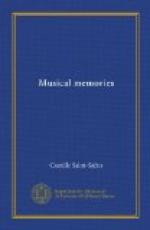We simply do not know how they played these anthems, masses, and madrigals, in the absence of any indication of either the time or the emphasis. We find a few directions for expression, as in the first measures of Palestrina’s Stabat Mater but such directions are extremely rare. They are simply the first signs of the dawn of the far-off day of music with expression. Certain learned and well-intentioned persons endeavor to compare this music with ours, and we surprise in some of the modern editions instances of molto expressivo which seem to be good guesses. This exclusively consonant music, in which the intervals of fourths were considered dissonant, while the diminishing fifth was the diabolus in musica, ought from its very nature to be antithetical to expression. Nothing in the Kyrie, in La Messe du Pape Marcel, gives the impression of a prayer, unless expressive accents, without any real justification, are introduced by main strength.
Expression came into existence with the chord of the dominant seventh from which all modern harmony developed. This invention is attributed to Monteverde. No matter what has been said, however, it occurs in Palestrina’s Adoremus. Floods of ink have been poured out in discussing this question, some affirming, while others—and not the least, by any manner of means—denying the existence of the famous chord. No equivocation is possible. It is a simultaneously played chord held by four voices for a whole measure. What is certain is that Palestrina, by putting aside the rules, made a discovery, the significance of which he did not realize.
With the introduction of the seventh interval a new era began. It would be a grave error to believe that the rules were overturned, for, instead, new principles were added to old ones as new conditions demanded. They learned how to modulate, how to transpose from one key to the next key and finally to the keys farthest away. In his treatise on harmony Fetis studied this evolution in a masterly manner. Unfortunately his scholarship was not combined with deep musical feeling. For example, he saw faults in Mozart and Beethoven where there are only beauties, and beauties which even an ignorant listener—if he is naturally musical—will see without trouble. He did not understand the vast difference between the unlettered person who commits a solecism and Pascal, the inventor of a new syntax.
However that may be, Fetis gave us a comprehensive review in broad outlines of musical evolution down to what he justly called the “omnitonic system,” which Richard Wagner has achieved since. “Beyond that,” he said, “I can see nothing more.”
He did not foresee the a-tonic system, but that is what we have come to. There is no longer any question of adding to the old rules new principles which are the natural expression of time and experience, but simply of casting aside all rules and every restraint.




